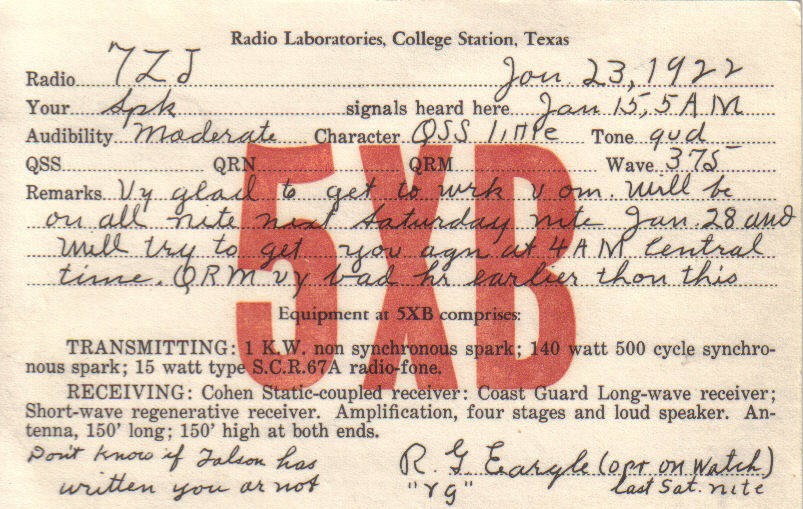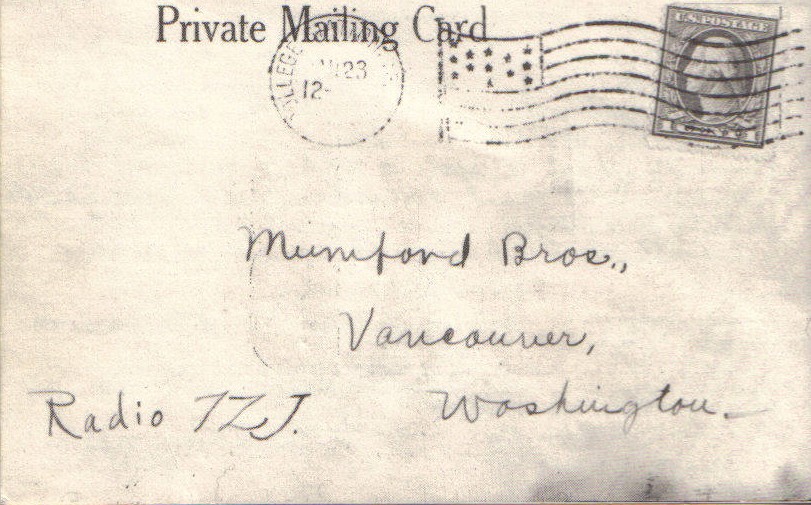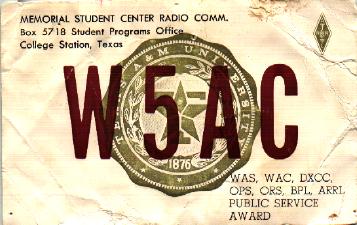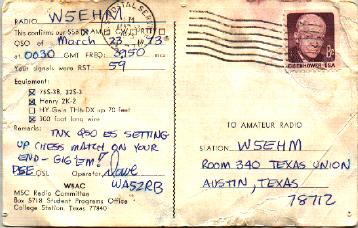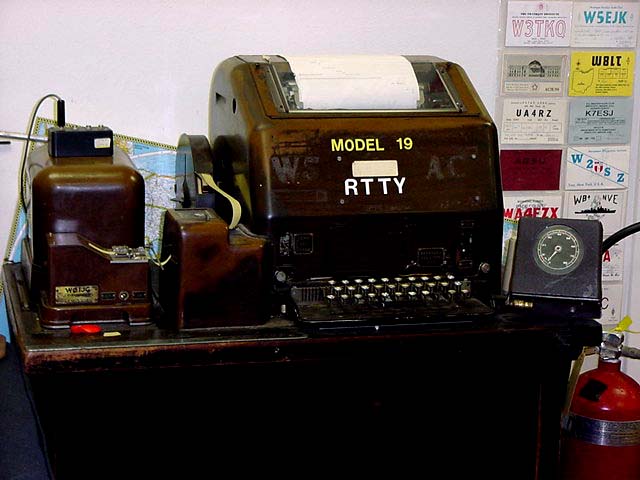History
Through the Decades
1912-1930
- 1912: The Amateur Radio Club at A.M.C. (Agricultural and Mechanical College of Texas, now Texas A&M University) is founded and licensed by the Department of Commerce.
- November 24, 1921: 5XB and 5XU (texas university) transmit the first play-by-play football broadcast.
- January 23, 1922: W5AC made a radio contact with Washington State using spark gap transmission, possibly setting a world record for that mode. By 1926, spark transmission was prohibited for use by hams, superceded by CW transmission.
- June 10, 1924: W5AC becomes an ARRL Affilliate.
1930-1950
- December 7, 1941: United States declares war on Japan, W1AW notifies all radio amateurs to cease operations.
1950-1970
- ~1954: Memorial Student Center opens, and W5AC relocates from Bolton Hall.
1970-1990
- ~1971: W5AC's first FM repeater on 146.82 MHz was built around 1971 by Bob Switzer W5IUP. It was tested in the apartment of W5XTT (then WB5BCT) and his XYL, KD5OGM.
1990-2010
2010-Current
- 2015: W5AC moves to the new shack by Hensel Park
- 2016: W5AC takes first place overall in School Club Roundup with 586,278 points.
- 2023: W5AC moves to the new shack at WEB 169
Detailed History
The amateur radio club at AMC* was founded and licensed in 1912. The club has been on campus ever since, making it one of the oldest university radio clubs in existence.
* Agricultural & Mechanical College of Texas, which would become Texas A&M University in 1963
The club's name during the early days was some variation of "Texas A&M College Radio Club." Early records show that we once made our transmissions from Bolton Hall, the Electrical Engineering building at the time. We were there at least until the construction of the MSC in the 1950's. We contacted 9 different countries in 1926 alone, not to mention the thousands of U.S. contacts in the logbooks. We've been affiliated with ARRL since June 10, 1924.
The "First Radio Broadcast of Football Game", was made possible by William A. "Doc" Tolson and others, and it is his picture which has become famous in association with that broadcast. After October 7, 1922, public broadcasts at the college were made from the callsign WTAW, which is still in use commercially (off campus) today. Amateur radio continued at 5XB, which changed its callsign to become W5AC today. While some say the call letters WTAW were chosen to spell "Watch The Aggies Win", the letters TAW are also the reverse of "Doc" Tolson's initials!
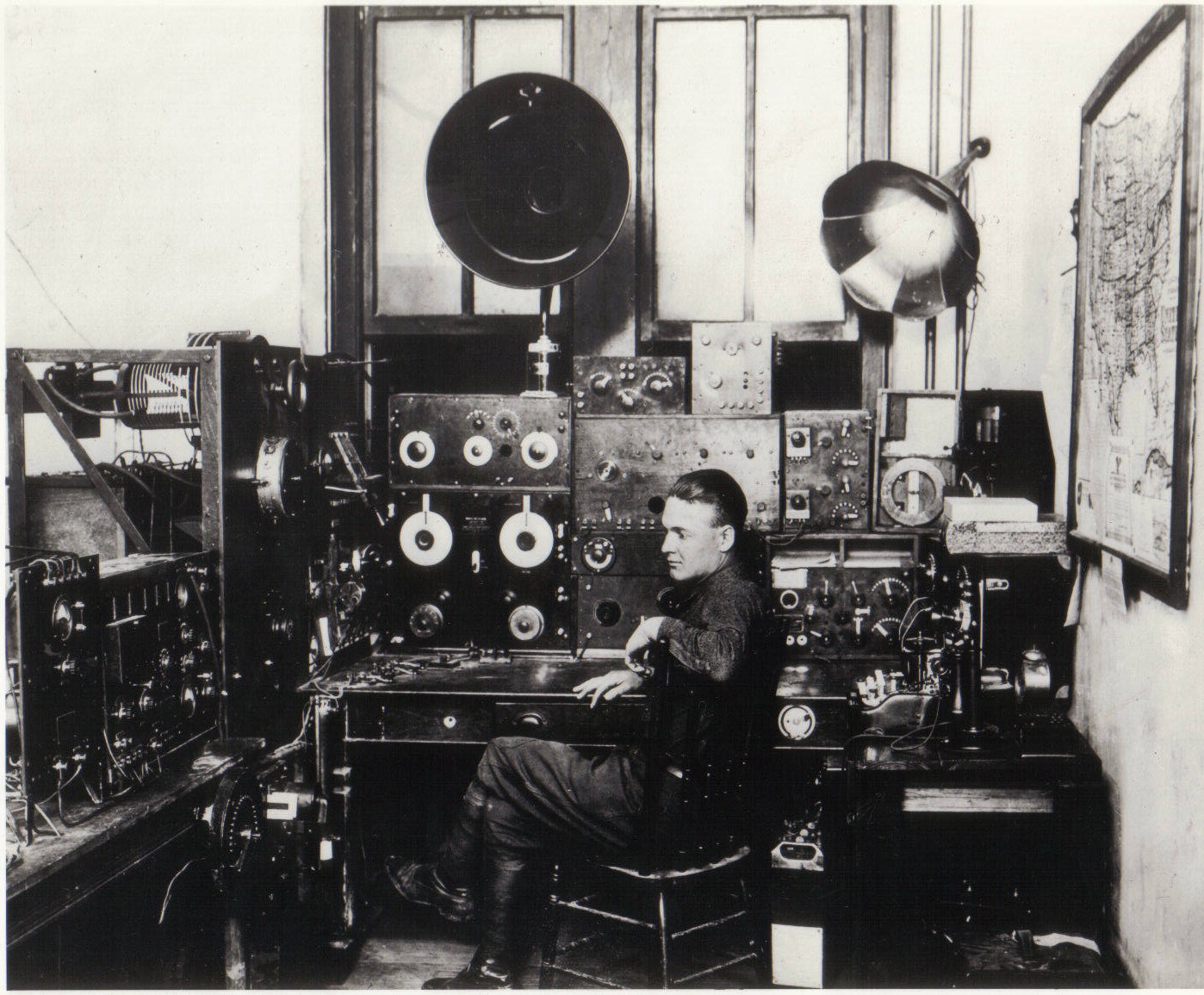
As history, and one of our logbooks shows, amateur radio transmissions were suspended during World War II.
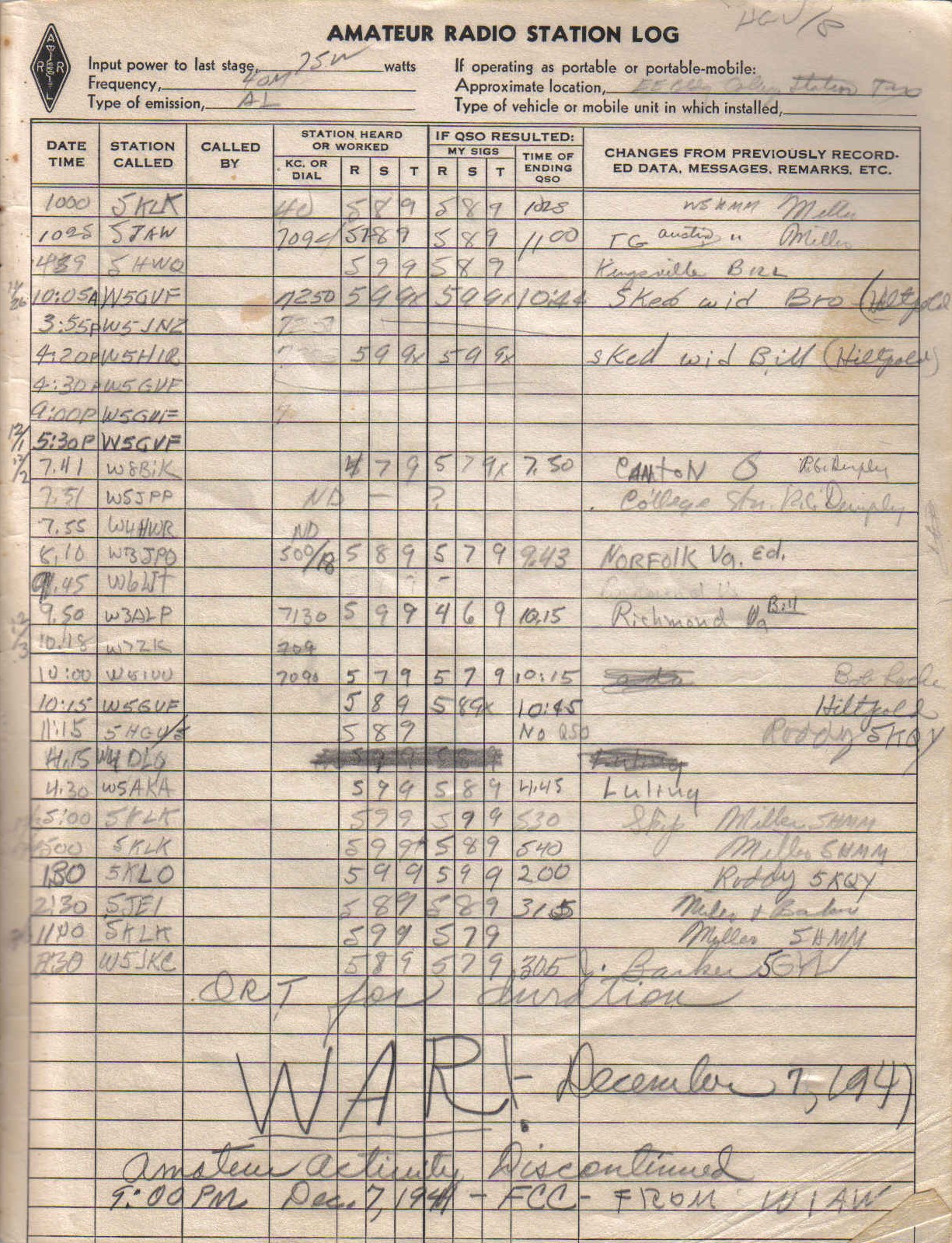
After the 1960's, the club was known as the "MSC Radio Committee". We were housed in the Memorial Student Center for a few years. We moved temporarily to Bizzell Hall in the early 1970's during remodeling of the MSC, at which time we installed our antennas on the Goodwin Hall tower that then held TAMU's weather radar. We've been located above the bowling alley and apparently in a guest room of the MSC hotel, among other rooms. In Fall of 1983, we moved from room 152 on the first floor to the west side of the building (next to offices of the Texas A&M Board of Regents) on the third floor. We renamed our unique student organization to the current name, the "Texas A&M University Amateur Radio Club". In 2015 we moved to a shack by the Hensel Park Transmitter Site. In May of 2022, we had our tower collapse and moved out of the shack. After moving out of the shack at Hensel Park, the club primarily operated portable for contests and events. In Fall of 2023, the club moved to a new shack in the Wisenbaker Engineering Building, where the club currently resides. There are no antennas on that building, however a remote station is in use.
Previous Callsigns
Our callsign has been W5AC since at least September 11, 1947. Former calls for W5AC include:
- 5AC, circa 1914,
- 5YA, Fall of 1920, (Y meant a Technical or Training School radio license)
- 5XB, late 1920 through at least 1923, (X meant an experimental radio license, which was allowed higher power output than Y stations)
- 5XAU, circa 1924,
- 5AQY, up to October 1, 1928*
- W5AQY, up to the 1940's, and
- AC5AC, our Centennial callsign (1976).
* On this date, "W" prefixes were added to existing amateur radio callsigns in the continental U.S. to identify them internationally.
Previous Transmissions
-
First play-by-play radio broadcast of a football game
Texas A&M electrical engineering students participated in the first play-by-play broadcast of a football game between Texas A&M and Texas on Thursday, November 24, 1921. Using equipment in the Electrical Engineering Department, they transmitted plays by pre-arranged code via telegraph key.Read more about the historic broadcast here.
-
In January of 1922, W5AC made a radio contact with Washington State using spark gap transmission, possibly setting a world record for that mode. By 1926, spark transmission was prohibited for use by hams, superceded by CW transmission.
-
W5AC's first FM repeater on 146.82 MHz was built around 1971 by Bob Switzer W5IUP. It was tested in the apartment of W5XTT (then WB5BCT) and his XYL, KD5OGM. The transmitter was connected to a coat hanger hung from the roof of the 1 story apartment, with a Ringo about 35 feet up for the receive antenna.
After testing, the transmit antenna was placed on the elevator of Kyle Field, while the receive antenna was on the MSC bell tower some distance away (no need for duplexers). They were linked with a private phone line that cost only $24 per year - a clever application of TAMU phone policy by W5AC members at the time.
Starting in late 1973, the repeater was located at the KAMU-TV Channel 15 tower (A&M's PBS broadcast station) just north of campus. Due to various interference problems, the repeater was apparently moved in late 1978 to Rudder Tower (from club records). In the summer of 1994, the repeater moved from a temporary location at our shack in the MSC back to Rudder Tower. Then, in February 2005, the repeater was moved to the 14th floor of the O&M (Oceanography and Meteorology) building on campus.
-
On March 23, 1973, Texas A&M and the University of Texas (or as we like to call our rivals, "t.u.") competed in a game of chess. The chess clubs of each school communicated their moves via amateur radio (3.950 MHz SSB and also two meter AM locally on the Austin end). Apparently the Aggies won this match. Below are images of the QSL card, which cost eight cents at the time. Thanks to N5XU and Dave WA5ZRB for use of the images, originally captioned with the following:
"Tnx QSO es setting up chess match on your end - gig 'em!"
-
On May 2, 1974, W5AC transmitted a 65-foot long telegram to that university in Austin, via Radio Teletype (RTTY). The telegram was signed by "a large cross-section of students", and took 8 W5AC members 4 hours to transmit.
Extremely long telegrams were a frequent activity of W5AC around that time, often sent to the Fish Drill Team when they were at the national drill competition in Washington, D.C. The Model 19 machine would run radio teletype (RTTY) on the 20 meter band for hours, breaking every 10 minutes to send identification.
Similar telegrams made their way to Aggies playing basketball in Austin in the late 1970's, covered with the names of students on campus wishing them well - another demonstration of "Aggie Spirit".
-
W5AC played a crucial part in the yearly construction of Bonfire in the decades before cellphones were practical. Cut sites that were 70 miles from A&M could only contact main campus via HF amateur radio. Even ambulances might be outside the range of line-of-sight radios at "cut", and ham radio would be the fastest way to get medical attention to anyone injured there.
Beginning in 1978, W5AC would host a special event - "CQ Bonfire" - during the burning of Bonfire, which attracted many former students.
-
Besides awards and emergency communication (EmComm) service listed below, we've also assisted the TAMU Ocean Drilling Program's JOIDES Resolution Drill Ship communicate back home to Aggieland while at sea.
-
In the recent past, W5AC rebroadcasted NASA Select TV Audio to 147.54 MHz during shuttle missions.
Awards
Below are some of the awards that the club has earned, and emergencies to which W5AC provided assistance.
- August 28, 1964 - ARRL Public Service Award "in consideration of meritorious work in connection with the Wichita Falls, Texas tornado (Apr. 3, 1964) as related on pages 52-54, Sept. 1964, QST".
- January 18, 1965 - ARRL Public Service Award "in consideration of meritorious work in connection with Hurricane Hilda (Oct. 1-5, 1964) as related on page 30, Jan. 1965, QST".
- September 24, 1965 - IARU's W.A.C. (Worked All Continents) Award. The award traditionally combines Australia and Pacific islands into "Oceania", and divides Antarctica between the other areas.
- November 5, 1965 - ARRL's W.A.S. (Worked All States) Operating Achievement Award (#16,455).
- May 16, 1967 - ARRL DX Century Club (#9108) (worked over 100 countries, since November 15, 1945).
Additional Countries Worked 110-160 170-180 190-210 270-280 280 12/13/68 02/03/70 03/15/71 06/27/88 - 1967 - ARRL recognition for our support during Central American earthquakes.
- June 28, 1967 - ARRL Public Service Award "in consideration of meritorious work in connection with The revolt in Managua, Nicaragua (Jan. 23-24, 1967) as detailed on page 77, June QST".
- Januar 11, 1968 - ARRL DX Century Club - Phone (#3929), with additions similar to above up to 225 countries.
- January 27, 1969 - ARRL W.A.C. Award with Phone (2-Way SSB).
- October 15, 1970 - ARRL Certificate of Performance (Foremost participating phone station in Southern Texas), in the Thirty-Sixth ARRL International DX Competition, February-March 1970.
- May 15, 1971 (with later endorsements) - ARRL appointment as an Official Relay Station.
- November 10, 1973 - WSA (Worked South America) certificate for conducting two-way SSB/CW communications with all 13 countries in South America.
- March 4, 1974 - Southwest Traffic Net, certificate of participation (#903A). This net met nightly from 2130-2230 (Central Time) on 3935 KHz, with stations in NM, TX, OK, AR, LA and MS participating.
- June 1, 1974 - College Bowl Contest - 1st Place, Texas College Club Station category, for 1973. "This award is given in recognition of Outstanding Achievement in Amateur Radio Communications and in support of the continued Advancement of the Amateur Radio Hobby on College Campuses."
- June 10, 1974 - ARRL Affiliation for 50 years.
- November 13, 1974 - From the editors of CQ ("The Radio Amateur's Journal"), W.A.Z. (Worked All Zones) Award (#3783). The world is divided into a total of 40 zones.
- February 4, 1976 - W5AC supported health and welfare traffic during the earthquake in Guatemala that killed 22,000 and left a million people (almost 1/6 of the population) homeless.
- November 1976 - ARRL Contest Achievement Award. Operator WB5OOW achieved First Place, Low Power entrant, in the Southern Texas Section of the 43rd November Sweepstakes, CW.
- May 12, 1977 - Certificate for working the required number of "Ten-Ten Net" members, a group located in Southern California which works 10 meters.
- 1977 - ARRL Contest Achievement Award. W5AC achieved First Place, Multioperator, in the Southern Texas Section of the ARRL 160 meter Contest.
- 1978 - ARRL Contest Achievement Award. W5AC (K5GN, WD5DLZ, oprs) achieved First Place, Multioperator, Phone, in the Southern Texas Section of the ARRL November Sweepstakes.
- 1978 - ARRL Contest Achievement Awards. W5AC (K5GN, WB5s LEU YDT, oprs) achieved First Place, Multi-Single, Phone, in the Southern Texas Section of the ARRL International DX Competition. W5AC(K5GN, N5TC, WB5YOT, oprs) also received First Place, Multi-Single, CW in the Southern Texas Section of the same contest, with Division Leader sticker.
- June 30, 1978 - Six Meter International Radio Klub (SMIRK) membership (#2666).
- April 10, 1979 - W5AC supported EmComm / health and welfare traffic during massive, deadly tornadoes in Wichita Falls and the Red River Valley area of Texas and Oklahoma. "Terrible Tuesday" saw unusually large F4 tornadoes that left 56 dead and over 1,900 injured.
- 1979 - ARRL Contest Achievement Award. W5AC (K5GN, WB5YOT, oprs) achieved First Place, Multi-Single CW, Southern Texas in the ARRL International DX Competition.
- 1979 and 1980 - IARU Radiosport Championship Diplomas for Operating Achievement, #1 Multioperator, Southern Texas. Section High Score; 1000 QSO's; 50 zones. 1979 operators K5s MW VK, WB5YOT, and WD5DLZ; 1980 operators K5GN, WB5s PYI ZDP, WD5s DLZ FFH.
- June 1, 1980 - From the editors of CQ ("The Radio Amateur's Journal"), Certificate of Merit to David K. McCarty K5GN, of W5AC, in recognition of winning the World-Wide DX Contest for the Single Operator All-Band CW division for U.S.A., Nr.2 in the Fifth Call Area.
- August 1980 - W5AC supported EmComm / health and welfare traffic once again during Hurricane Allen, at one point a Category 5 hurricane in the Gulf of Mexico.
- September 13, 1983 - The American National Red Cross "in grateful appreciation" for our support a month earlier during Hurricane Alicia.
- Ocbober 1985 - American Red Cross Certificate of Appreciation "for generously supporting Brazos County Red Cross disaster relief efforts during Mexico's earthquake".
- December 16, 1986 - ARRL DX Century Club (#3862) (worked over 100 countries; additional sticker for working over 150 countries).
- 1987 - ARRL International DX Contest Award. WQ5C, op, achieved (as Single Operator on 15 meters in South Texas Section) 1st Place, Phone, 2nd Place, CW and 6th Place, W/VE.
- March 1, 1993 - AMSAT membership, Member Society No. A-407.
- 1996 - Certificate of Contact, awarded for making contact with all of the special event calls associated with KN4WL and the 1996 Olympic Games in Atlanta, Georgia (40 Meter SSB - H.H.H. Net)
- 2003 - IARU HF World Championship, Certificate for Operating Achievement, Single Operator, CW Only, South Texas Section. 250 QSOs; 50 multipliers. NT5TU, op.
- 2003 - WAEDC (Worked All Europe DX Contest), #1 in United States Call Area 5 for single operator/LP division (SSB), Op. NT5TU. 58 QSOs, 56 QTCs, 6,384 points.
- April 2003 - Florida QSO Party, Fourth Place, US Schools.

